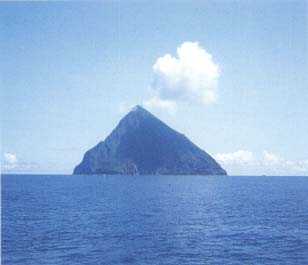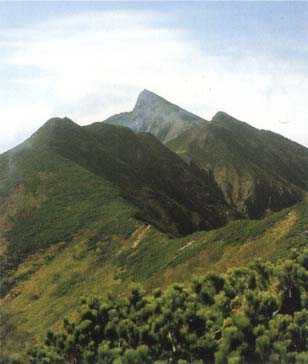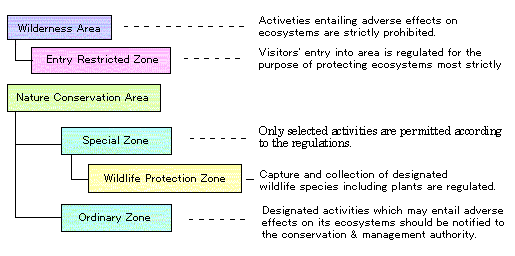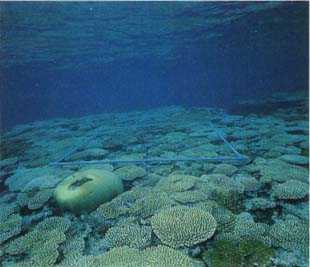Nature & Parks
Nature Conservation in Japan -Section 4
[Policies & Programs] Nature Conservation in Japan
4. Wilderness Area and Nature Conservation Area
4.1 Category

Minami-Iwojima Wilderness Area

Onnebetsudake Wilderness Area
The Nature Conservation Law, which provides the basic frames for nature conservation, is to protect and manage natural resources and natural ecosystems in cooperation with other related laws.
In accordance with this Law, following areas are established.
- Wilderness Area:
Area that preserves and maintains its original characteristic ecosystems without any influence of human activities. - Nature Conservation Area:
Natural area that preserves and maintains its valuable natural ecosystems characterized by:
- (a)Alpine and subalpine vegetation
- (b)Valuable natural forests
- (c)Typical landscape, geology and natural phenomena
- (d)River, lake, marsh, and sea coast with valuable wildlife
- (e)Marine area with valuable wildlife
- (f)Habitats of plants and animals maintaining good natural environment being comparable to (a)-(e)
- Prefectural Nature Conservation Area: Area that preserves and maintains valuable natural environment at the prefectural level, but does not include marine areas.
[Policies & Programs] Nature Conservation in Japan
4.Wilderness Area and Nature Conservation Area
4.2 Designation
Wilderness Areas and Nature Conservation Areas are designated by the Director General of the Environment Agency after conferring with related governmental agencies and consulting with the Nature Conservation Council. Prefectural Nature Conservation Areas are designated by the Governor of the Prefecture concerned
Wilderness Areas and Nature Conservation Area
| Item | Number | Area (ha) |
|---|---|---|
| Wilderness Area | 5 | 5,631 |
| Nature Conservation Area | 10 | 21,593 |
| Prefectural Nature Conservation Area | 516 | 73,405 |
As of March 31, 1995
[Policies & Programs] Nature Conservation in Japan
4.Wilderness Area and Nature Conservation Area
4.3 Zoning for Protection of Ecosystems

[Policies & Programs] Nature Conservation in Japan
4.Wilderness Area and Nature Conservation Area
4.4 Scientific Survey

Scientific Survey
(Sakiyamawan Nature Conservation Area)
In order to make sure of the strict protection and management of the designated areas and to increase public awareness on nature conservation, the comprehensive scientific survey have been undertaken in such areas since 1980 by the Environment Agency. All Wilderness Areas and Nature Conservation Areas have already extensively surveyed by Japanese top scientists team organized by the Environment Agency. In Minami-Iwojima, for example, some of new species and species which were believed to have been extinct were identified.
Wilderness Area Total : 5 areas 5,631 ha.
| District | Prefecture | Area (ha) | Land ownership | Data of designation | Features of natural environment | Remarks |
|---|---|---|---|---|---|---|
| Onnebetsudake | Hokkaido | 1,895 | National forest | Feb. 4, 1980 | Alpine vegetation mainly composed of creeping pines | No entry-restricted zone |
| Head of River Tokachi | Hokkaido | 1,035 | National forest | Dec. 28, 1977 | Virgin forest of silver fir and fir tree | No entry- restricted zone |
| Head of River Ooi | Shizuoka | 1,115 | National forest | Mar. 22, 1976 | Temperate zone conifer forest and subarctic zone conifer forest | No entry- restricted zone |
| Minami Iwojima (Island) | Tokyo | 367 | National forest | May 17, 1975 | Tropical and subtropical vegetation, geographical features eroded by wave, sea birds | All areas designated as entry restricted zone (on June 24, 1983) |
| Yakushima (Island) | Kagoshima | 1,219 | National forest | May 17, 1975 | Temperate zone evergreen broadleaved forest mainly composed of natural cedar and pasania | No entry- restricted zone |
As of February 1, 1992
Nature Conservation Area Total : 10 areas 21,593 ha.
| District | Prefecture | Area (ha) | Land ownership | Data of designation | Features of natural environment | Remarks |
|---|---|---|---|---|---|---|
| Ohirayama | Hokkaido | 674 | National forest | Dec. 28, 1977 | Natural forest of beech trees (Fagus crenata) located close to the northern limit, Limestone rock vegetation. | All areas designated as special zone and wildlife protection zone. |
| Shirakami sanchi | Aomori, Akita | 14,043 | National forest | Oct 7 , 1992 | The largest natural beech forest in Japan. Valuable flora and fauna, e.g. Black woodpecker | Part of areas designated as special zone and wildlife protection zone |
| Hayachine | Iwate | 1,370 | National forest | May 17, 1975 | Alpine and subalpine vegetation, characteristic vegetation of Serpentine's mountain area, Vertical distribution of beechtree's zone to alpine zone vegetation. | All areas designated as special zone. Part of them designated as wildlife protection zone. |
| Wagadake | Iwate | 1,451 | National forest | May 21, 1981 | Beech tree forest, Natural forest of "mountain recess oak" (Qleerdus monolica ver.) , creeping pine forest, permanent snowfield vegetation. | All areas designated as special zone and wildlife protection zone. |
| 0sabiyama | Tochigi | 545 | National forest | May. 16, 1981 | Alpine and subalpine vegetation, Natural beech forest. | All areas designated as special zone. |
| Head of River Tone | Gunma | 2,318 | National forest | Dec. 28, 1977 | Alpine low tree forest, beech trees, Natural forest of Quereus mongolica var., permanent snowfield vegetation, snowbridge zone's characteristic vegetation | All areas designated as special zone and wildlife protection zone. |
| Sasagamine | Ehime, Kochi | 537 | National forest and private forest | Mar. 31, 1982 | Beech tree forest, "Shikoku-Shirabe" (evergreen conifer belonging to pine species) | All areas designated as special zone. Part of them designated as wildlife protection zone. |
| Shiragadake | Kumamoto | 150 | National forest | Mar. 21, 1980 | Natural beech forest located close to the southern limit distribution. | All areas designated as special zone. |
| Inaodake | Kagoshima | 377 | National forest | May 17, 1975 | Evergreen broad-leaved forest mainly composed of witch-hazels and "Urajiro oaks" (belonging to beech tree's species) | All areas designated as special zone. |
| Sakiyamawan (Bay) | Okinawa | 128 | Sea Surface | May 28, 1983 | Large communities of "Azami" coral, coral reef | All areas designated as marine special zone. |
as of February 1, 1994
Ministry of the Environment Government of Japan